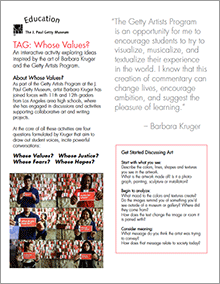
As the Whose Values project quickly approaches its closing date—August 2—I’ve been reflecting on my experience working on the project and how deeply it has inspired me both as an artist and an educator. So many of the themes that bubbled forth during Whose Values hit home for me; topics I seek to unravel both in my own work as well as thread throughout the curriculum I teach to K–12 art students.
After spending months working on the implementation of the Whose Values project both at the Museum and in the classrooms of our two participating high schools, I was excited to see how my own class of middle school art students would respond to the four big questions about values, hopes, fears, and justice. The tagging-wall project felt like a particularly good fit for my class of socially conscientious middle schoolers from the Country School in Valley Village, because the core of their education is based on individualized learning, developing emotional intelligence, and each student finding his or her own voice and way in the world.
It was also a great opportunity to try out the fabulous TAG: Whose Values lesson plan developed by our education team at the Getty. This free PDF download provides a great step-by-step activity for introducing Barbara Kruger’s work, the four big questions, and the totality of the Whose Values project within a classroom setting. It also comes complete with printable tags for students to complete and hang in their own classroom.
TAG: Whose Values (PDF, 4 pp.)
My students were already familiar with Kruger’s work from a prior lesson, so we started the tag lesson with a refresher and revisited some of her most iconic images. Building on suggestions provided on the lesson plan, I posed the following questions to my students:
- What colors do you see?
- Are the images and colors bold or muted?
- How does this affect the overall feeling you get when you look at the image?
We then discussed how they felt these elements help convey particular meanings and what they felt those meanings might be:
- What do you think Barbara Kruger was trying to say by juxtaposing the particular images she did?
Next I showed them images from an album and talked about my experience with the project and how we could extend the tagging portion to our own classroom. As this particular class was very small (less than 15 students), I had every student complete a tag for each of the four questions. Their responses included the following:
What do you hope for?
Order nor chaos, only the in-between
Money
What do you fear?
Spiders
The unknown
The dark
Getting rejected
Justice for whom?
Everyone
Animals
Women
People of different races
What do you value?
Love and friendship
Life
Finally, we decided that the best place to hang our tags was on our classroom tree so they would be visible to all of the other students who come in and out of the room.

Students’ completed Whose Values tags hang from a paper tree in my classroom
Bringing this lesson into the classroom provided a wonderful connection for students who may not have the opportunity to see the Whose Values installation in person. The lesson plan made it extremely easy to transition Whose Values into the classroom and to introduce the mural project to students not directly involved in its creation. My middle school class was very inspired by the fact that students not much older than they got to work with Barbara Kruger directly and have their art installed at the Getty.





Comments on this post are now closed.